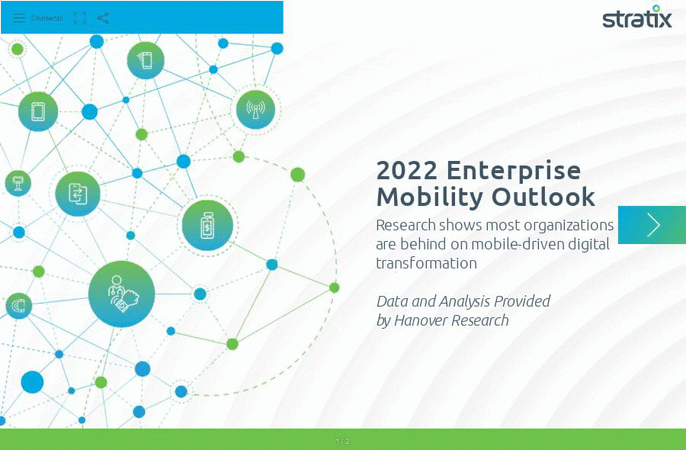3 Key Findings from the Stratix 2022 Enterprise Mobility Outlook Report
Written by Elizabeth Klingseisen
2 Min Read
Blog
As an enterprise mobility leader, it’s important for Stratix to study industry trends to see how mobile technology is being used, what challenges exist, and what strategies can accelerate digital transformation that leads to greater success. We’re now in our third year of issuing our annual Enterprise Mobility Outlook report. With this year’s research, we wanted to get a complete report card on how organizations are doing after two years of pandemic disruption.
Mobile devices have played a key role in navigating that disruption by improving remote work and protecting frontline workers with solutions like contactless transactions. With 5G now widely available, we anticipate new innovations that will offer competitive advantages to companies that adopt them early.
The 2022 Enterprise Mobility Outlook offers a high-level ranking of how organizations are doing on mobile-driven digital transformation as they adopt mobile-first principles that put mobility at the heart of strategy, operations, and user experiences. Some of the other key findings for 2022 involve device use strategies and internal IT team challenges within organizations.
Organizations Prefer to Own Technology
Despite a lot of buzz around Bring Your Own Device (BYOD) policies in recent years, our research found enterprises own nearly all the equipment employees use to do their jobs. Only 14 percent have BYOD policies.
Security is likely a big reason why. Forty percent of respondents in Verizon’s annual Mobile Security Index said mobile devices are their company’s biggest security risk. Considering that the average cost of a data breach now sits at $4.2 million, organizations aren’t enthusiastic about letting personal devices access sensitive data and applications. Employees are also unwilling to give employers full control over their devices, citing privacy concerns, so it looks like BYOD will remain small for now.
Workers Don’t Share Well
About 20 percent of organizations ask some employees to share devices. Even though 89 percent of them stay with one employee for their entire shift, there are significant management problems, like getting the devices back to the charging cradle, check-in/check-out processes, battery life, and more. Retailers report the most recharging issues, along with battery life and longer wait times. Transportation organizations have problems with device storage and checking them in and out.
Because of the challenges, 61 percent of organizations plan to modify their shared device strategies. They plan to do it by buying devices with a longer lifecycle, updating procedures and security, upgrading the operating system, and shifting to personally assigned devices.
Finding Qualified IT Staff Remains Difficult
IT teams devote a significant amount of time to managing mobile technology. One-third of in-house IT departments spend all week on mobile technology security, and a further 20 percent spend all week on end-user support. That adds up to fifty percent of their time allotted to mobile.
Only 17 percent of organizations say they have no difficulty finding the right people to manage mobile tech in-house. Because the majority do, they often rely on relationships with Mobile Managed Services Providers (MMSPs).
When choosing a partner, the research shows they value MMSPs that “can do it all” with solutions that manage all aspects of mobile technology. It gives them the expertise and scale to manage mobile solutions effectively by partnering with providers who have the resources and knowledge to help them steer clear of problems that can stall deployments, cause poor user experiences, or hurt ROI.
Read the Report
There’s a lot more information on how enterprises are leveraging mobile-first strategies in our full 2022 Enterprise Mobility Outlook. Read it today for valuable insights.

2022 ENTERPRISE MOBILITY OUTLOOK
Research shows most organizations are behind on mobile-driven digital transformation.
Read Report













